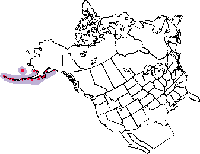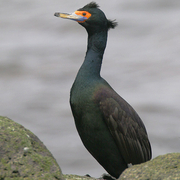Red-faced Cormorant
Phalacrocorax
urile
Pelecaniformes
These birds are aquatic, medium-sized to large, and feed on small fish and other animals found in the water. One of their most distinctive features is their feet, which have webbing between all four toes. Many have an unfeathered and sometimes brightly colored pouch of varying size at the throat. Most nest in colonies. Representatives of five of the order's six families have been found in Washington:
Phalacrocoracidae
Cormorants are large birds with long, flexible necks, short, rounded wings, and wedge-shaped tails. Most are predominantly shiny black, and males and females look alike. Diving to catch fish, they swim underwater and use their feet but not their wings to propel themselves. Their feathers get waterlogged quickly, which aids them in diving by reducing their buoyancy. As a result, they need to dry out between dives, and many species are often seen perched with wings spread. Distributed throughout temperate and tropical waters, cormorants most often live along marine coastlines, but a few species live on inland waters as well. They are colony nesters, nesting on banks, cliffs, or trees, often on islands. Both parents raise the young.
General Description
One bird seen at mouth of Elwha River in May 1999.
North American Range Map







